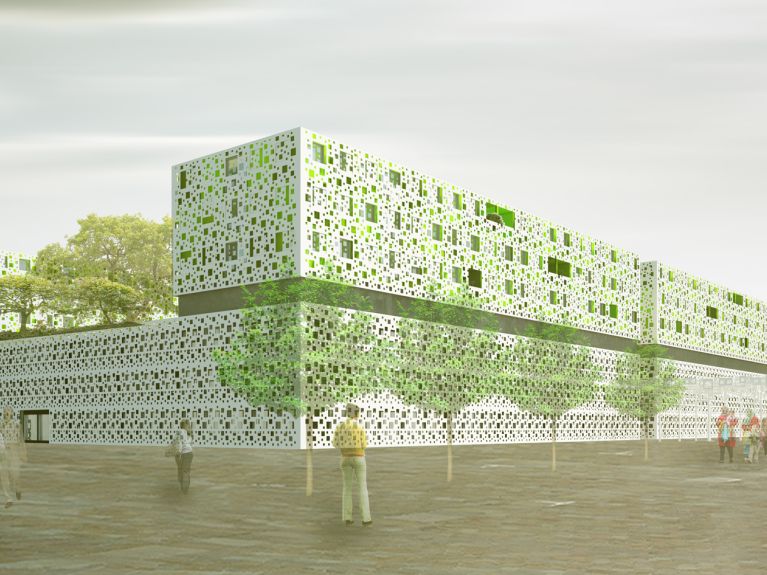Fast assembly for rapid assistance
Young architect Sarah Friede has designed a modular hospital. Her concept could revolutionize humanitarian aid.

Germany. Severely injured people who are receiving insufficient care due to the damage sustained by hospitals – such images from war and disaster zones are especially harrowing. Medical infrastructure has to be up and running again as quickly as possible. Sarah Friede has taken this approach to develop a hospital building-block system in the context of her Master’s thesis at Lübeck University of Applied Sciences. Standardized modules – square boxes with steel frames – may be connected to form differently sized rooms and stacked several floors high. These construction elements may form operating theatres, patient rooms or laboratories. Electrical cables and plug sockets come pre-installed. The prototype, a seven-storey building with two U-shaped tracts, is to be realized in Syria. The impetus for the project came from Professor Oliver Rentzsch, expert on the healthcare and medical industries.
Ms. Friede, Mr. Rentzsch, what is the background to your project?
Oliver Rentzsch: “I was in Syria on behalf of the World Health Organization (WHO) in order to take stock of the state of the healthcare services there. In view of the destruction of the hospital in the city of Homs and the state of other hospitals in the country it soon became clear that we would not be able to avoid constructing new buildings. This created several problems: Construction would need to be fast, low-cost, high quality, and on site. I approached Lübeck University of Applied Sciences with the problem, and that is how Ms. Friede got involved in the project.

Ms. Friede, which architectural and cultural challenges did you face?
At first I found it difficult planning a hospital for a different culture. During our studies we covered the guidelines for building hospitals in Germany and Europe. But in Syria the requirements are different in several areas; the birth rate is much higher and gender segregation plays a role. On top of this, there are different priorities in clinical procedures in crisis situations. What helped a lot was speaking to a Syrian man with relatives in healthcare. He provided me with information and blueprints and translated Arabic documents for me. I tried to establish a cultural connection through the design of the façade, the rooms and the courtyards. But the fact that the hospital is to be built by Syrians on site should also lead to the greatest possible degree of acceptance.
Sarah Friede’s modular hospital system is a milestone for the global community.
When can construction of the new hospital in Homs start?
The financing is still up in the air and we haven’t finished the detailed planning. But at least the authorities in Syria want to implement the “Friede model”. And the WHO has confirmed that it wants to support the project. That is already a lot. We are “merely” waiting for a political decision from the donors. But one thing is certain: There are no humanitarian alternatives. We have to help the local people, independent of the interests of the countries involved.

How long will it take you to build the hospital once you have approval?
If we got the green light for the project in Homs tomorrow, we could complete it in early 2019. We need about a year’s notice and a year until completion. But any other hospitals after this prototype could be built a lot faster. Thanks to the modular construction method it would then be an automatic process, with the government responsible implementing it on its own initiative.
This is our understanding of emergency aid: support in transferring technology from Germany in order to help solve humanitarian problems. Yet realization and responsibility both need to be rooted at the local level, because that’s the only way to make these projects sustainable in the longer term. I think other countries will take on the “Friede model” too, because the technology is convincing.
Ms Friede, are you planning to transfer this modular model to other types of building?
There is the idea of transferring this concept to schools, but it is not yet being discussed in concrete terms. Right now it is a question of completing the development of the hospital project and building the prototype. I can certainly imagine transferring the approach to other humanitarian aid projects.
Further information: AIHD Modular System
